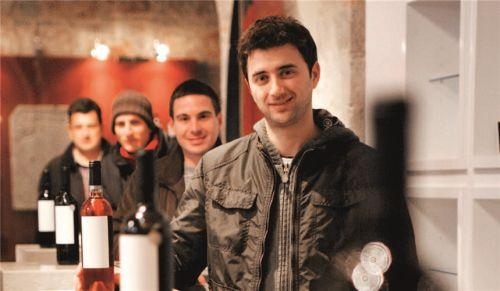All of the interviews in the series are going to be similar, with 8 same questions and 2 questions tailored specifically for each winemaker (those two will be easy to spot, as they will be coloured differently).
Could you please introduce yourself, your winery, your wines for our readers. How did you get into winemaking, and can you tell us a bit about your ethos of making wine?
My name is Rikard Petrić, I’m 32 and been working as a winemaker for the last 8 years. I have been in Stina all that time but also did few vintages abroad to get some new experiences and ideas. Stina is very modern mid-size winery continuing over a century long tradition of wine production. We are located in Bol, Island Brač, traditional winegrowing region with lot of sun, famous for it’s full bodied reds. Our focus is in local varietis plavac mali (red) and pošip (white).
I came into contact with winemaking from early age from helping my family, nothing too serious, but got really into it after my graduation. My ethos is to get the best fruit out of the vineyard that you possibly can, and then take care of it in winery as best as you can and know.
How was the last harvest in your vineyards? What do you expect of the 2016 wines? Do you have any specific expectations, plans or hopes for this vintage?
In regards to white varieties, it was similar to year before, meaning it was good with some weather factors that were stressful for the vines without which the year would have been perfect. But it was still a good year.
However, 2016 was exceptional for reds. Everything was great regarding weather conditions and fruit characteristics, really enjoyed it from start to finish. It will be a banner year for sure.
It is still to early to say anything about 2017, I hope it to be as good as 2016.
What are the Croatian wines (up to three whites and three reds) you think everyone should buy and taste at least once (not including any of yours, please)? Why?
Oh wow, I don’t like these kinds of questions because I will leave out some great wines. Right now I feel everybody shoud try these reds: Benvenuti Teran, Babić Gracin, Markus Plavac. All great wines, local varieties and a great runthrough from north to south of Croatian coastline. As for the whites: definitely Krauthaker’s Graševina, Krajančić Posip Intrada (amazing), and some malvazija from Istria, they are all good.
Can you please comment on the status of winemaking on the island of Brač? It has a long tradition, but it is quite obvious that other islands have done much more in the winemaking recently. Is your winery helping change the tide in that sense?
I would say that we are, as you always need a bigger winery to pave the path for other, smaller ones. Not only for this island but more. Winemaking on Brač has a very long and famous tradition, we have all the prerequisites so at least here, the future is looking good.
What do you think about the situation in the Croatian winemaking these days? What would you change if you could, regarding the legislation, the market or anything else? Would you agree with the idea that Croatian wines are too expensive, which is something you can often hear?
Less of really unnecessary regulations on wineries and more inclusion of people from the industry when making legislations would be a great start. This is far to big of a topic, there is a lot to be done. I would agree that our wines are expensive, but it’s because the production is still quite expensive, mostly due to the small production volumes.
How do you see the relationship between the Croatian restaurants and the winemakers? Do Croatian restaurants promote and appreciate Croatian wines as much as they should, how do their margins affect the sale of Croatian wines?
I think it’s a necessary and a mutually beneficial relationship. From my experience being in a tourist area (I’m not in sales so I don’t know so much about other parts of the country) I can see that they prefer to sell good local wine because guests like to try while they are on their holiday. We are fortunate for this aspect because it facilitates wine export and sales.
Your winery is not family-owned; rather it’s an industrial investment of sorts. How would you comment the situation in Croatian winemaking in terms of relationships between small family-sized winemakers and larger enterprises such as Stina, are those maybe an unfair competition to each other?
As I said before, it does not have to be so much of a competition if we get focused on export as much as we should. I guess if we keep all the sales locally then competition is inevitable and the big ones will take the better of the small ones but if we take a more distant look then entire Croatia is so small that we should really work together and push each other forward.
What do you think about the future of wine-making in Croatia, strategically how should it advance? Should we attempt exporting more Croatian wines? Can you comment on the changes which happened after our accession to the EU, specifically weigh in on the benefits of a larger market for export vs. the dangers of easier import of cheaper wines?
It’s gonna be more and more challenging. I think export is the only right way to go and we should do as much as we can to increase it, tourism can be of great help for this.
Still, Croatian people prefer Croatian wines but for sure there will be more good wines for less money and only the best ones will make it. It’s really time to understand the important role of marketing of wines.
Do you think new vineyards in Croatia should be mostly indigenous varieties, or should more international wines be planted?
I think both. But definitely focus should be on the indigenous varieties, simply because they are so good.
Paint us a picture of a perfect setting for enjoying a bottle of your wine. Which bottle did you choose, why?
At this moment I am drinking lot of Rieslings so I would say nature, spring sun, maybe a river nearby. But thats just how I’ve been feeling these days…
Previously in the series of interviews:
Tomislav Tomac
Frano Baničević











